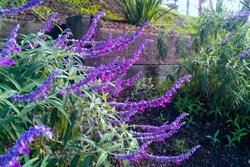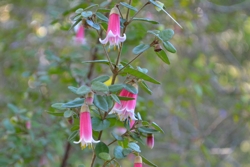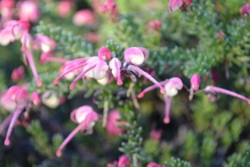Water Conservation in Central California
 Central California enjoys a climate that is classified as "Mediterranean" – characterized by warm, dry summers and mild winters with low rainfall. In many areas of the Central Coast available municipal water is limited. Customers are encouraged to conserve, and regulations govern the use of landscape water. Implementing water-wise landscaping techniques can achieve at least a 50% reduction in water used compared with conventional landscaping practices. Sue Powell offers consultation on landscape water use and provides recommendations for effective water conservation practices.
Central California enjoys a climate that is classified as "Mediterranean" – characterized by warm, dry summers and mild winters with low rainfall. In many areas of the Central Coast available municipal water is limited. Customers are encouraged to conserve, and regulations govern the use of landscape water. Implementing water-wise landscaping techniques can achieve at least a 50% reduction in water used compared with conventional landscaping practices. Sue Powell offers consultation on landscape water use and provides recommendations for effective water conservation practices.
Landscape Management Techniques
There are many landscape management techniques that decrease the amount of water needed to maintain a garden full of beautiful plants. Adding organic material to the soil increases water retention and decreases the need for irrigation water. Organic material also increases nitrogen in the soil, so plants are well-nourished and healthy. Applying a thick layer of mulch over the surface of a planting area also increases water retention and decreases the amount of water needed from irrigation. Creating swales on hillsides can decrease the amount of water run-off from either irrigation or rainfall. Decreasing the area of lawns in a landscape or replacing lawns with native grasses can significantly reduce water use, and many municipalities are now offering rebates for removal of water-thirsty lawns. Installing efficient irrigation systems, decreasing the time that the system operates, and running the system early in the morning can all reduce the amount of water used on a landscape.
Drought-Tolerant Plants
 To comply with local water-use ordinances and to reduce costs for maintaining landscapes, many Central Coast gardeners are interested in using drought-tolerant plants. These plants need only minimal irrigation water once they are established. They need regular watering during the first two years after planting, but in successive years, they survive with little water during the dry season and flourish with winter rains. Many of these plants are native to Central California. Others originated in other regions regions of the world that also have a Mediterranean climate, such as South Africa, Australia, the coast of South America, and the Canary Islands.
To comply with local water-use ordinances and to reduce costs for maintaining landscapes, many Central Coast gardeners are interested in using drought-tolerant plants. These plants need only minimal irrigation water once they are established. They need regular watering during the first two years after planting, but in successive years, they survive with little water during the dry season and flourish with winter rains. Many of these plants are native to Central California. Others originated in other regions regions of the world that also have a Mediterranean climate, such as South Africa, Australia, the coast of South America, and the Canary Islands.
Many very interesting drought-tolerant plants are sold by Sierra Azul Nursery in Santa Cruz County. The Nursery also offers a two-acre demonstration garden that highlights plants adapted to a Mediterranean climate.
 MARIPOSA LANDSCAPING
MARIPOSA LANDSCAPING